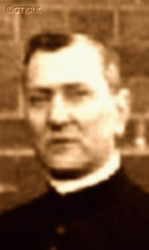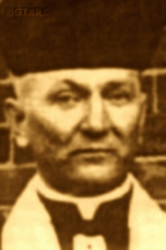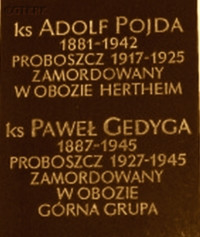Roman Catholic
St Sigismund parish
05-507 Słomczyn
85 Wiślana Str.
Konstancin deanery
Warsaw archdiocese, Poland
full list:
displayClick to display full list

searchClick to search full list by categories
wyświetlKliknij by wyświetlić pełną listę po polsku

szukajKliknij by przeszukać listę wg kategorii po polsku

Martyrology of the clergy — Poland
XX century (1914 – 1989)
personal data
religious status
Servant of God
surname
GEDIGA
surname
versions/aliases
GEDYGA
forename(s)
Paul Ernest (pl. Paweł Ernest)
function
diocesan priest
creed
Latin (Roman Catholic) Church RCmore on
en.wikipedia.org
[access: 2014.09.21]
diocese / province
Berlin diocesemore on
en.wikipedia.org
[access: 2013.12.04]
Wrocław diocesemore on
en.wikipedia.org
[access: 2013.05.19]
nationality
German
date and place
of death
28.05.1945

Górna Grupatoday: Dragacz gm., Świecie pov., Kuyavia‐Pomerania voiv., Poland
more on
en.wikipedia.org
[access: 2021.09.02]
alt. dates and places
of death
22.06.1912
details of death
In 1921, after the plebiscite in Upper Silesia, remained in the parish, that was allocated to Poland.
In 1926 exchanged parishes with a Polish priest, Fr Adolphus Pojda, and moved to Pomerania, to Słupsk.
There, during Russian winter offensive of 1945 ending the World War II started by German and Russian invasion of Poland in 09.1939 arrested by the Russians on 12.04.1945 (or earlier, on 08.03.1945) — Słupsk was captured by the Russians on 08.03.1945.
For a fortnight jailed in a transit camp in Słupsk.
Then transported east — with intention to send to one of the Russian POW concentration camps deep in Russia.
Brought to a transit camp in Górna Grupa, where perished — prob. from hunger.
alt. details of death
Perished from starvation.
cause of death
extermination
perpetrators
Russians
sites and events
DL Ober GruppeClick to display the description, Reichsgau Danzig‐WestpreußenClick to display the description, Ribbentrop‐MolotovClick to display the description, Pius XI's encyclicalsClick to display the description
date and place
of birth
18.06.1887

Ostrożnicatoday: Pawłowiczki gm., Kędzierzyn‐Koźle pov., Opole voiv., Poland
more on
en.wikipedia.org
[access: 2022.01.28]
presbyter (holy orders)
ordination
22.06.1912

Wrocławtoday: Wrocław city pov., Lower Silesia voiv., Poland
more on
en.wikipedia.org
[access: 2021.04.02]
positions held
till 1945
dean — Koszalintoday: Koszalin city pov., West Pomerania voiv., Poland
more on
en.wikipedia.org
[access: 2022.01.28] RC deanery
1927 – 1945
parish priest — Słupsktoday: Słupsk city pov., Pomerania voiv., Poland
more on
en.wikipedia.org
[access: 2022.01.22] ⋄ RC parish
1920 – c. 1926
parish priest — Leszczynytoday: district of Czerwionka‐Leszczyny, Czerwionka‐Leszczyny gm., Rybnik pov., Silesia voiv., Poland
more on
en.wikipedia.org
[access: 2020.11.27] ⋄ Holy Trinity RC parish ⋄ Dębieńskotoday: district of Czerwionka‐Leszczyny, Czerwionka‐Leszczyny gm., Rybnik pov., Silesia voiv., Poland
more on
en.wikipedia.org
[access: 2020.11.27] RC deanery
1918 – 1920
vicar — Dębieńsko Wielkietoday: Dębieńsko district of Czerwionka‐Leszczyny, Czerwionka‐Leszczyny gm., Rybnik pov., Silesia voiv., Poland
more on
en.wikipedia.org
[access: 2020.11.27] ⋄ St George the Martyr RC parish ⋄ Dębieńsko Wielkietoday: Dębieńsko district of Czerwionka‐Leszczyny, Czerwionka‐Leszczyny gm., Rybnik pov., Silesia voiv., Poland
more on
en.wikipedia.org
[access: 2020.11.27] RC deanery
1916 – 1918
vicar — Rudyalso: Rudy Wielkie
today: Kuźnia Raciborska gm., Racibórz pov., Silesia voiv., Poland
more on
en.wikipedia.org
[access: 2021.04.02] ⋄ Assumption of the Blessed Virgin Mary RC parish ⋄ Gliwicetoday: Gliwice city pov., Silesia voiv., Poland
more on
en.wikipedia.org
[access: 2021.04.02] RC deanery
1912 – 1916
vicar — Łanytoday: Cisek gm., Kędzierzyn‐Koźle pov., Opole voiv., Poland
more on
en.wikipedia.org
[access: 2022.02.15] ⋄ St Bartholomew the Apostle RC parish ⋄ Łanytoday: Cisek gm., Kędzierzyn‐Koźle pov., Opole voiv., Poland
more on
en.wikipedia.org
[access: 2022.02.15] RC deanery — from 07.07.1915 administrator
till 1912
student — Wrocławtoday: Wrocław city pov., Lower Silesia voiv., Poland
more on
en.wikipedia.org
[access: 2021.04.02] ⋄ philosophy and theology, Theological Seminary
others related
in death
POJDAClick to display biography Adolph
sites and events
descriptions
DL Ober Gruppe: From 10.1939 till c. 04.1940, in the Divine Word Missionaries SVD Congregation's house in Górna Grupa — taken over by the Germans after the suspension of the activities of the Minor Seminary run by the friars, and their internment, and the repurposing of the building for military purposes — the Germans organized a Germ. Durchgangslager (Eng. Transit camp), i.e. DL Ober Gruppe, for Poles, including 95 Polish clergy, from the Świecie, Bydgoszcz, Chełmno, Grudziądz, and Starogard Gdański regions in Pomerania. C. 50 of them — detained as part of the Germ. «Intelligenzaktion» (Eng. „Action Intelligence”), i.e. the extermination of the Polish intelligentsia and leadership classes in Pomerania — perished, a significant number of them murdered at the execution sites in Mniszek‐Grupa. In the same place in 1945 Russians set up a concentration camp for Germans, among whom two priests perished. (more on: pl.wikipedia.orgClick to attempt to display webpage
[access: 2021.12.19], www.kpbc.ukw.edu.plClick to attempt to display webpage
[access: 2013.12.27])
Reichsgau Danzig‐Westpreußen: After the Polish defeat in the 09.1939 campaign, which was the result of the Ribbentrop‐Molotov Pact and constituted the first stage of World War II, and the beginning of German occupation in part of Poland (in the other, eastern part of Poland, the Russian occupation began), the Germans divided the occupied Polish territory into five main regions (and a few smaller). The largest one was transformed into Germ. Generalgouvernement (Eng. General Governorate), intended exclusively for Poles and Jews and constituting part of the so‐called Germ. Großdeutschland (Eng. Greater Germany). Two were added to existing German provinces. From two other separate new provinces were created. Vistula Pomerania region was one of them, incorporated into Germany on 08.10.1939, by decree of the German leader Adolf Hitler (formally came into force on 26.10.1939), and on 02.11.1939 transformed into the Germ. Reichsgau Danzig‐Westpreußen (Eng. Reich District of Gdańsk‐West Prussia) province, in which the law of the German state was to apply. The main axis of the policy of the new province, the territory of which the Germans recognized as the Germ. „Ursprünglich Deutsche” (Eng. „natively German”), despite the fact that 85% of its inhabitants were Poles, was Germ. „Entpolonisierung” (Eng. „Depolonisation”), i.e. forced Germanization. C. 60,000 Poles were murdered in 1939‐1940, as part of the Germ. „Intelligenzaktion”, i.e. extermination of Polish intelligentsia and ruling classes, in c. 432 places of mass executions — including c. 220 Polish Catholic priests. The same number were sent to German concentration camps, from where few returned (over 300 priests were arrested, of whom c. 130 died in concentration camps). C. 124,000‐170,000 were displaced, including c. 90,000 to the Germ. Generalgouvernement. Poles were forced en masse to sign the German nationality list, the Germ. Deutsche Volksliste DVL. Polish children could only learn in German. It was forbidden to use the Polish language during Catholic Holy Masses and during confession. Polish landed estates were confiscated..To further reduce the number of the Polish population, Poles were sent to forced labor deep inside Germany. The remaining Poles were treated as low‐skilled labor, isolated from the Germans and strictly controlled — legally, three or three of them could only meet together, even in their own apartments. Many were conscripted into the German Wehrmacht army. After the end of hostilities of World War II, the overseer of this province, the Germ. Reichsstatthalter (Eng. Reich Governor) and the Germ. Gauleiter (Eng. district head) of the German National Socialist Party, Albert Maria Forster, was executed. (more on: en.wikipedia.orgClick to attempt to display webpage
[access: 2024.06.24])
Ribbentrop‐Molotov: Genocidal Russian‐German alliance pact between Russian leader Joseph Stalin and German leader Adolf Hitler signed on 23.08.1939 in Moscow by respective foreign ministers, Mr. Vyacheslav Molotov for Russia and Joachim von Ribbentrop for Germany. The pact sanctioned and was the direct cause of joint Russian and German invasion of Poland and the outbreak of the World War II in 09.1939. In a political sense, the pact was an attempt to restore the status quo ante before 1914, with one exception, namely the „commercial” exchange of the so‐called „Kingdom of Poland”, which in 1914 was part of the Russian Empire, fore Eastern Galicia (today's western Ukraine), in 1914 belonging to the Austro‐Hungarian Empire. Galicia, including Lviv, was to be taken over by the Russians, the „Kingdom of Poland” — under the name of the General Governorate — Germany. The resultant „war was one of the greatest calamities and dramas of humanity in history, for two atheistic and anti‐Christian ideologies — national and international socialism — rejected God and His fifth Decalogue commandment: Thou shall not kill!” (Abp Stanislav Gądecki, 01.09.2019). The decisions taken — backed up by the betrayal of the formal allies of Poland, France and Germany, which on 12.09.1939, at a joint conference in Abbeville, decided not to provide aid to attacked Poland and not to take military action against Germany (a clear breach of treaty obligations with Poland) — were on 28.09.1939 slightly altered and made more precise when a treaty on „German‐Russian boundaries and friendship” was agreed by the same murderous signatories. One of its findings was establishment of spheres of influence in Central and Eastern Europe and in consequence IV partition of Poland. In one of its secret annexes agreed, that: „the Signatories will not tolerate on its respective territories any Polish propaganda that affects the territory of the other Side. On their respective territories they will suppress all such propaganda and inform each other of the measures taken to accomplish it”. The agreements resulted in a series of meeting between two genocidal organization representing both sides — German Gestapo and Russian NKVD when coordination of efforts to exterminate Polish intelligentsia and Polish leading classes (in Germany called «Intelligenzaktion», in Russia took the form of Katyń massacres) where discussed. Resulted in deaths of hundreds of thousands of Polish intelligentsia, including thousands of priests presented here, and tens of millions of ordinary people,. The results of this Russian‐German pact lasted till 1989 and are still in evidence even today. (more on: en.wikipedia.orgClick to attempt to display webpage
[access: 2015.09.30])
Pius XI's encyclicals: Facing the creation of two totalitarian systems in Europe, which seemed to compete with each other, though there were more similarities than contradictions between them, Pope Pius XI issued in 03.1937 (within 5 days) two encyclicals. In the „Mit brennender Sorge” (Eng. „With Burning Concern”) published on 14.03.1938, condemned the national socialism prevailing in Germany. The Pope wrote: „Whoever, following the old Germanic‐pre‐Christian beliefs, puts various impersonal fate in the place of a personal God, denies the wisdom of God and Providence […], whoever exalts earthly values: race or nation, or state, or state system, representatives of state power or other fundamental values of human society, […] and makes them the highest standard of all values, including religious ones, and idolizes them, this one […] is far from true faith in God and from a worldview corresponding to such faith”. On 19.03.1937, published „Divini Redemptoris” (Eng. „Divine Redeemer”), in which criticized Russian communism, dialectical materialism and the class struggle theory. The Pope wrote: „Communism deprives man of freedom, and therefore the spiritual basis of all life norms. It deprives the human person of all his dignity and any moral support with which he could resist the onslaught of blind passions […] This is the new gospel that Bolshevik and godless communism preaches as a message of salvation and redemption of humanity”… Pius XI demanded that the established human law be subjected to the natural law of God , recommended the implementation of the ideal of a Christian state and society, and called on Catholics to resist. Two years later, National Socialist Germany and Communist Russia came together and started World War II. (more on: www.vatican.vaClick to attempt to display webpage
[access: 2023.05.28], www.vatican.vaClick to attempt to display webpage
[access: 2023.05.28])
sources
personal:
www.w.linux.media.plClick to attempt to display webpage
[access: 2014.11.28], www.parafiaostroznica.republika.plClick to attempt to display webpage
[access: 2014.11.28], newsaints.faithweb.comClick to attempt to display webpage
[access: 2025.04.13]
original images:
www.w.linux.media.plClick to attempt to display webpage
[access: 2014.11.28], www.w.linux.media.plClick to attempt to display webpage
[access: 2016.05.30], www.zieja.ovh.orgClick to attempt to display webpage
[access: 2016.05.30]
LETTER to CUSTODIAN/ADMINISTRATOR
If you have an Email client on your communicator/computer — such as Mozilla Thunderbird, Windows Mail or Microsoft Outlook, described at WikipediaPatrz:
en.wikipedia.org, among others — try the link below, please:
LETTER to CUSTODIAN/ADMINISTRATORClick and try to call your own Email client
If however you do not run such a client or the above link is not active please send an email to the Custodian/Administrator using your account — in your customary email/correspondence engine — at the following address:

giving the following as the subject:
MARTYROLOGY: GEDIGA Paul Ernest
To return to the biography press below:
 Click to return to biography
Click to return to biography










